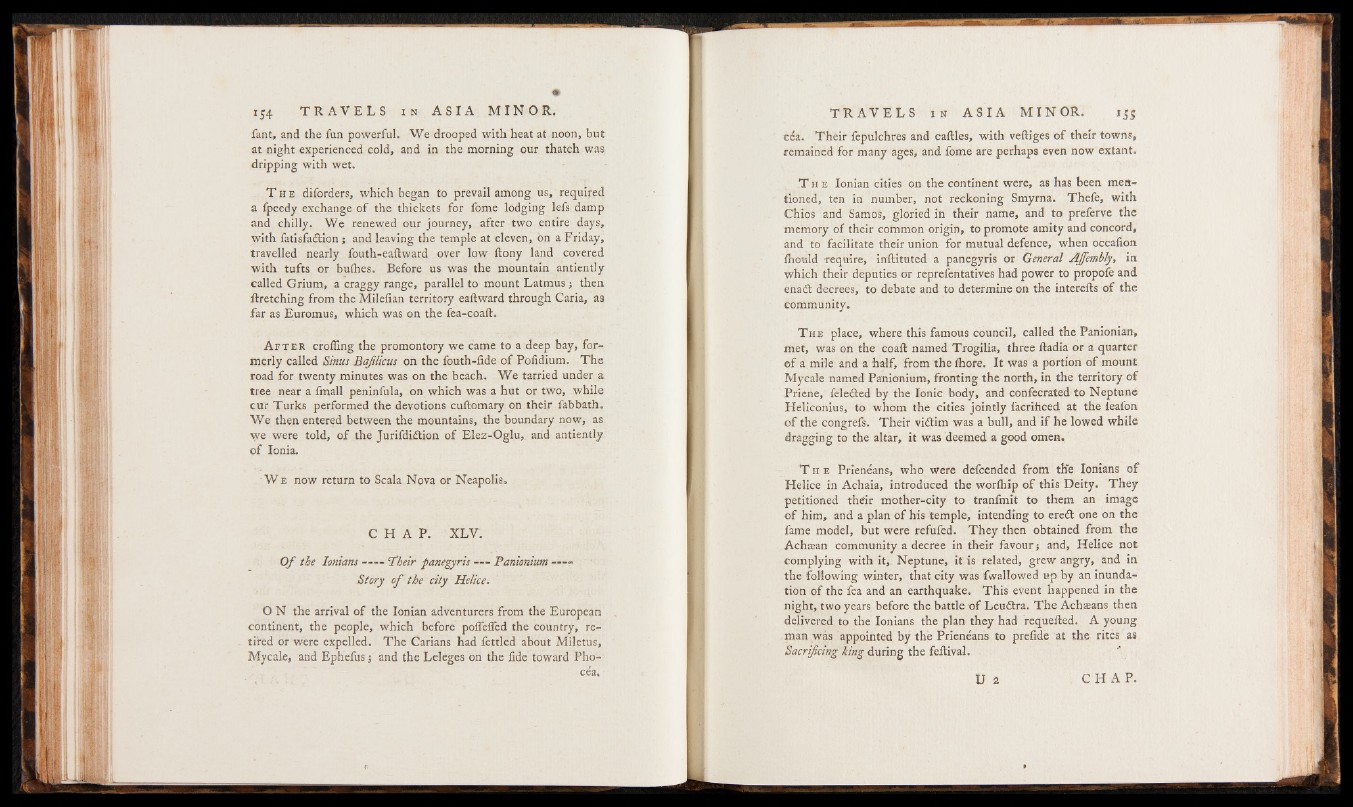
*54
fant, and the fun powerful. We drooped with heat at noon, but
at night experienced cold, and in the morning our thatch was
dripping with wet.
T he diforders, which began to prevail among us, required
a fpeedy exchange of the thickets for fome lodging lefs damp
and chilly. We renewed our journey, after two entire days,
with fatisfadlion ; and leaving the temple at eleven, on a Friday,
travelled nearly fouth-eaftward over low ftony land covered
with tufts or bullies. Before us was the mountain antiently
called Grium, a craggy range, parallel to mount Latmus ; then
firetching from the Milefian territory eallward through Caria, as
far as Euromus, which was on the fea-coaft.
A f t e r croffing the promontory we came to a deep bay, formerly
called Sinus Bajtlicus on the fouth-fide of Pofidium. The
road for twenty minutes was on the beach. We tarried under a
tree near a fmall peninfula, on which was a hut or two, while
cur Turks performed the devotions cuflomary on their fabbath.
We then entered between the mountains, the boundary now, as
\ve were told, of the Jurifdidtion of Elez-Oglu, and antiently
of Ionia.
W e now return to Scala Nova or Neapolia.
C H A P . XLV.
O f the Ionians---- fheir panegyris — Panionium-----
Story o f the city Helice.
O N the arrival of the Ionian adventurers from the European
continent, the people, which before poflefled the country, retired
or were expelled. The Carians had fettled about Miletus,
Mycale, and Ephefus; and the Leleges on the fide toward Phocda.
Their fepulchres and caflles, with veftiges of their towns,
remained for many ages, and fome are perhaps even now extant.
T he Ionian cities on the continent were, as has been mentioned,
ten in number, not reckoning Smyrna. Thefe, with
Chios and Samos, gloried in therr name, and to preferve the
memory of their common origin, to promote amity and concord,
and to facilitate their union for mutual defence, when occafion
fhould require, inilituted a panegyris or General AJfembly, in
which their deputies or reprefentatives had power to propofe and
enadt decrees, to debate and to determine on the inter-efts of the
community.
T he place, where this famous council, called the Panionian,
met, was on the coaft named Trogilia, three ftadia or a quarter
of a mile and a half, from the fhore. It was a portion of mount
Mycale named Panionium, fronting the north, in the territory of
Pricne, feledted by the Ionic body, and confecrated to Neptune
Heliconius, to whom the cities jointly facrificed at the feafon
of the congrefs. Their vidtim was a bull, and if he lowed while
dragging to the altar, it was deemed a good omen.
T he Prieneans, who were defcended from the Ionians of
Helice in Achaia, introduced the worlhip of this Deity. They
petitioned their mother-city to tranfmit to them an image
of him, and a plan of his temple, intending to eredt one on the
fame model, but were refufed. They then obtained from the
Achasan community a decree in their favour j and, Helice not
complying with it, Neptune, it is related, grew angry, and in
the following winter, that city was fwallowed up by an inundation
of the fea and an earthquake. This event happened in the
night, two years before the battle o f Leudlra. The Achaeans then
delivered to the Ionians the plan they had requefted. A young
man was appointed by the Prieneans to prefide at the rités as
Sacrificing king during the feftival.